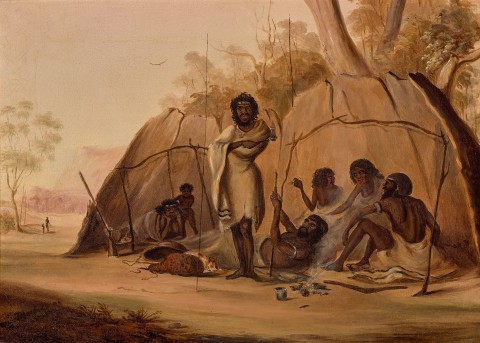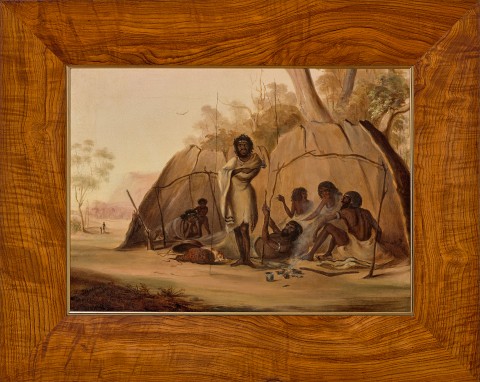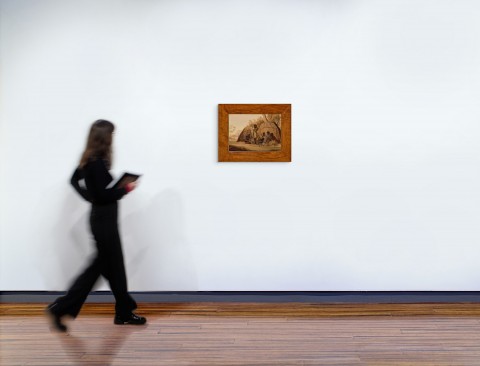ABORIGINAL ENCAMPMENT, 1847
THOMAS BALCOMBE
oil on canvas
33.0 x 45.5 cm
signed and dated lower left: T. Balcombe / 1847
Private collection, United Kingdom
Christie’s, London, 25 May 1983, lot 177 (as 'A Group of Aborigines Gathered Around a Camp Fire')
Private collection, Melbourne
Australian Paintings Colonial/Contemporary, Deutscher Fine Art, Melbourne, 2 – 19 April 1984, cat. 5 (illus. in exhibition catalogue)
The Artist and the Patron, Art Gallery of New South Wales, Sydney, 2 March – 1 May 1988, cat. 82
McDonald, P., and Pearce, B., The Artist and the Patron, Art Gallery of New South Wales, Sydney, 1988, cat. 82, pp. 101 (illus.), 102
Thomas Balcombe Gundaroo Natives, 1853
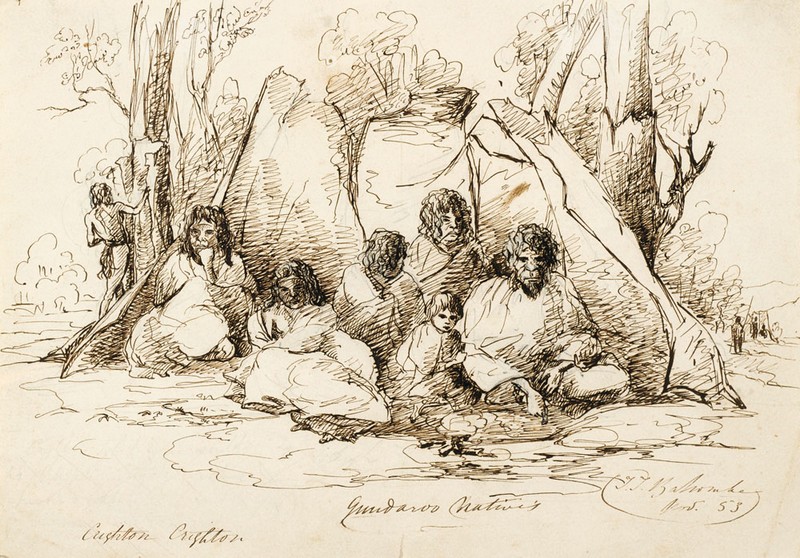
|
Thomas Balcombe
Gundaroo Natives, 1853
ink and pencil on paper
18.0 x 25.0 cm
Courtesy of Menzies
|
This important painting of an Aboriginal family at rest is one of the few such oil paintings remaining in private hands. It has not been seen in public since its inclusion in the Art Gallery of New South Wales’ bicentenary exhibition of colonial New South Wales art in 1988.1 Thomas Tyrwhitt Balcombe was born in 1810 on the remote Atlantic island of St Helena, where Napoleon was subsequently imprisoned (1815 – 1821). The Balcombe family became friendly with the ex-Emperor, such that father William was recalled to England in 1818 for over-familiarity. Six years later, the Balcombe family emigrated to New South Wales when William was appointed colonial treasurer of the colony. From the age of twenty, Thomas worked in the Surveyor-General’s Department, firstly as draftsman and then surveyor, travelling widely for his work, including on Major Thomas Mitchell’s third expedition through southern Australia. During this time, he met and observed Aboriginal communities, and sketches he made later served as inspiration for his paintings. In the 1840s, Balcombe began producing sporting lithographs and, by the end of the decade, he was exhibiting oil paintings in local societies and art unions. Wide-ranging in his subject matter and media, Balcombe produced portraits of racehorses, prized dogs and stock; stockmen and Sydney identities; and capitalised on the interest in the goldfields with visual documentation and humorous illustration. But it is his scenes of Aboriginal activity – at a time by which customary life was violently and increasingly constrained by colonists – that are of the most significance for examination and interpretation today.
Lot 25 - Supps.jpg
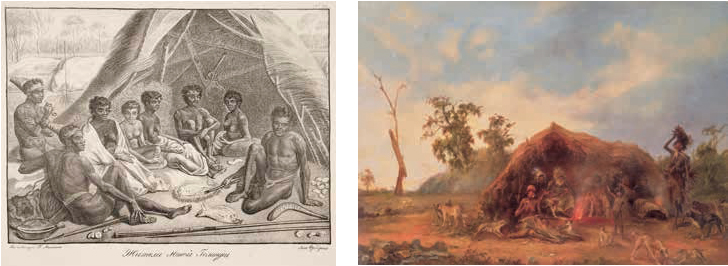
|
Pavel Mikailov (after)
Natives of New Holland (Bungaree and his family), plate 22 in The Voyage of Captain Bellingshausen to the
Antarctic Seas, 1819-21
State Library of New South Wales, Sydney
|
Alexander Schramm
Native Encampment in South Australia, c.1859
oil on canvas, 49.5 x 67.5 cm
Private collection
|
In this substantial oil painting, Balcombe depicts a family sheltering under gunyahs made of large sheets of bark arranged on forked branches. The group, comprising three bearded men, three women and a toddler, are relaxed, conversing by a small fire, the child playing with their mother’s hair. A small dog sleeps, curled up by woven fibre baskets while the standing man looks calmly towards the viewer. In the distance, an adult and child suggest an extended community. Balcombe shows the family continuing to live traditionally, with arm and headbands and ritual scarification marks, hunting with boomerang and spears, and using stone axes. Yet colonial impact is also evident: the men are wrapped with blankets with patterned borders, of the kind distributed annually, the women smoke clay pipes, and a metal container sits by the fire. Most unusually, a gun rests against the shelter, an implement rarely possessed by Aboriginal men.
In 2019, an archive of preparatory sketches and art by Balcombe was sold by descendants and acquired by the National Library of Australia, State Library of New South Wales and elsewhere. Among these was an 1853 study titled Gundaroo natives that depicts another family, probably Gandangara or Ngunnawal people, seated by a similar gunyah, behind which a man strips bark from a gum tree. This family, however, is fully covered by garments and cloaks or blankets, facing towards the viewer as though posed for a photograph, their postures not of self-contained contentment but resignation, with eyes downcast.
Further studies by Balcombe are more mannered, including a well-muscled man poised to spear fish (a study for night fishing paintings), and a head study that confirms Balcombe as the artist of a dramatic oil painting that was first exhibited in 1850.2 In this, an Aboriginal man ‘in pursuit of game’ strides determinedly over a rocky landscape, his possum-skin cloak swirling around him, revealing his torso like a gladiatorial statue.
Alexander Schramm Native Encampment in South Australia, c.1859
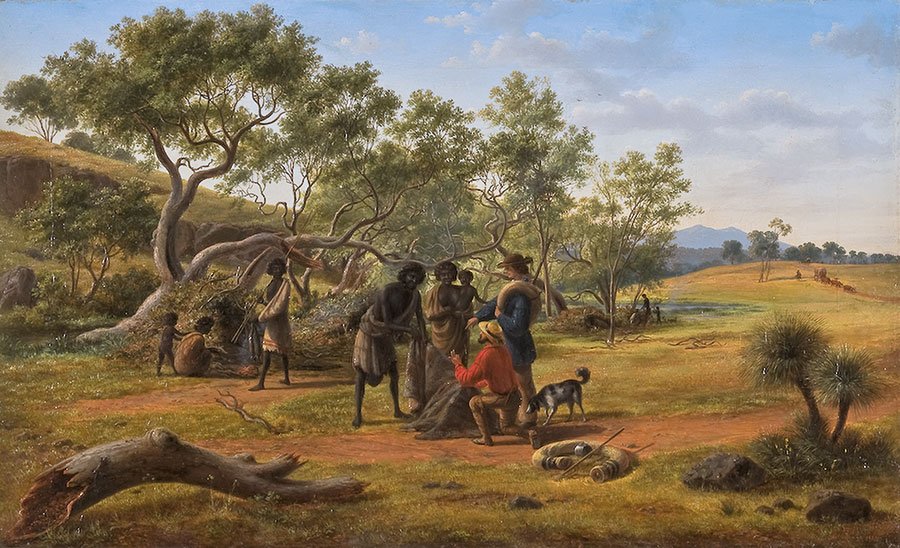
|
Eugene von Guérard
Aborigines met on the road to the diggings, 1854
oil on canvas, 46.0 x 75.5 cm
Geelong Gallery, Victoria
|
The painting on offer, however, does not appear heroised, nor derogatory (as was increasingly the case in colonial visual imagery of Aboriginal people), but seems more likely to record a family met during the course of Balcombe’s surveying. The important role played by Indigenous guides and local knowledge holders in assisting, sometimes saving, explorers, surveyors and collectors is now well recognised.3 Balcombe would have known Wiradjuri man Piper who accompanied Mitchell’s party in 1836. Similarly, artists such as Russian visitor to Sydney Pavel Mikailov, Eugene von Guérard in Victoria and Alexander Schramm in South Australia also recorded family groups that they met on their travels. Schramm often showed Aboriginal people impacted by invasion, using pipes, clothing, axes and mirrors; in contrast, von Guérard’s significant painting, Aborigines met on the way to the diggings, 1854 depicts active interaction in which both parties trade valued goods. Balcombe’s painting might be regarded as merging aspects of such encounters, the group making use of both customary and introduced apparel and utensils, while the central man, whose face Balcombe depicts with care, may be an individual known to their party, valued for his abilities and entrusted with a gun to assist them with provisions.
1. Pearce, B. and McDonald, P., The Artist and the Patron: Aspects of Colonial Art in New South Wales, Art Gallery of New South Wales, Sydney, 1988
2. See State Library of New South Wales SSV/162, study for ML 1453, ML 1454; P2/578, study for ML 568.
3. See for example, Olsen, P. and Russell, L., Australia’s First Naturalists, National Library of Australia, Canberra, 2019, and Clark, P., Aboriginal Plant Collectors, Rosenberg Publishing, Sydney, 2008
ALISA BUNBURY
